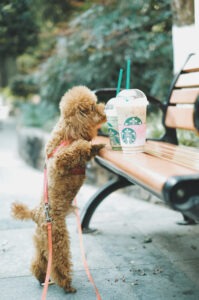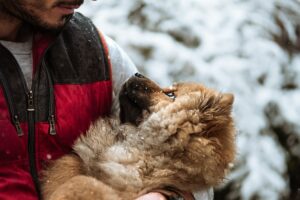Puppy Seekers
“We Socialize Puppies” – What Good Socialization Practices Look Like and What to Watch Out For
What is Socialization?
Technically “socialization” is the complex process that begins even before birth, by which an animal – including every human – becomes familiar and habituated to the environment in which it lives. For humans, it’s learning what is “normal” – about our surroundings, social interactions, and values and taboos. “Good” socialization in people, then, might look like learning these things early, learning them well, and learning broadly – about many different environments. With good socialization people can be successful in navigating through many contexts and not…well, be completely awkward in too many of them.
 Anyone who has been awkward before can appreciate the value of good socialization.
Anyone who has been awkward before can appreciate the value of good socialization.
It is well established that children who have more opportunities to participate in diverse activities and groups of people, for example, will develop better social skills. This is one important way “privilege” is passed on between generations. Having successful social interactions early on is also exponential: young kids with good socialization are better at making friends, and thus better at navigating the pre-school playrooms, the dreaded school hallways, and eventually even the competitive job market.
Importantly, experience itself is not enough. We have all experienced being in a new environment we were not ready for, or one that was set up poorly, causing us to feel that terrible, aforementioned, awkwardness, and then vowing to avoid that environment in the future.
Some years ago I worked in what is commonly known as a Life-skills Programs for Youth, a program for kids 8-18 who had not had a lot of opportunities when they were young to be successful socially in many environments, or who found social interactions particularly difficult for one reason or another. The goal was to introduce them to lots of new environments now, but, critically, in ways that set them up to succeed. This meant gradually, with lots of affirmation and going in prepared with a “script”.
 A classic example in this program was for youth to practice ordering a drink at Starbucks. For most of us, this is a very familiar environment, and while we don’t know what exactly all the drink options are, we have no problem ordering a drink. When you think about it, really, coffee culture requires knowing a lot of insider norms – from the unique names of cup sizes, to deciphering the menu and customizations. If you just put someone without that knowledge in front of the till, with a long lineup of people behind them waiting impatiently, you risk not only failure, but also creating anxiety – and with just a few repeated experiences like that, that anxiety can generalize across novel situations. My friend’s husband did not grow up in a subculture that involved ordering fancy coffee – charmingly (to me and my friend) he tried to cover his anxiety for the first year they dated, a year of many coffee shop visits, by only ever ordering “a Mocha” (eventually he added a Hazelnut Latte into his repertoire. These days his orders are as, or more, complicated as the next person’s).
A classic example in this program was for youth to practice ordering a drink at Starbucks. For most of us, this is a very familiar environment, and while we don’t know what exactly all the drink options are, we have no problem ordering a drink. When you think about it, really, coffee culture requires knowing a lot of insider norms – from the unique names of cup sizes, to deciphering the menu and customizations. If you just put someone without that knowledge in front of the till, with a long lineup of people behind them waiting impatiently, you risk not only failure, but also creating anxiety – and with just a few repeated experiences like that, that anxiety can generalize across novel situations. My friend’s husband did not grow up in a subculture that involved ordering fancy coffee – charmingly (to me and my friend) he tried to cover his anxiety for the first year they dated, a year of many coffee shop visits, by only ever ordering “a Mocha” (eventually he added a Hazelnut Latte into his repertoire. These days his orders are as, or more, complicated as the next person’s).
Following the example of the Life Skills Program above, what would be the right way to “socialize” a teenager (or a boyfriend) who has significant anxiety about doing the wrong thing at Starbucks? How would you set them up for ordering a drink, while using that opportunity to build confidence for similar future encounters? Whatever you do, keep it intentional. Be aware of the process, and how the process should be tailored to the age and background of the individual you are working with.
In this particular case I would start with the learner being in the space, with you, while feeling positive, perhaps being served a favourite drink, and playing a game you have played in other contexts and they enjoy. Keep in mind that you are working with a teenager – so keep it real chill and normalize everything. And definitely be cool.
A next step would be allowing them to observe you making an order, repeatedly.
Then deciding in advance on a simple menu selection, rehearsing the order, and then challenging them to try it out, once they feel ready. And if they blank in front of the cashier, either support them by speaking the order for them, or get out of the line-up and try again another day. It’s key to abort the mission before anxiety gets too high. If we have moved too fast or made the order too difficult notes should be made to remember that, and the plan potentially adjusted.
Once successful, the practice is repeated many times, with different orders, different Starbucks locations and different levels of support from you.
That confidence that comes with being successful at a challenging task can then be taken to another novel environment, where the same steps are repeated. Over time, the necessity for support and the chance of anxiety reduces across all novel environments, because there is a base level of generalized confidence.
The same steps would be taken to help people get used to a wide variety of challenging environments. I had a bad experience in the past of a tent collapsing on me in the dark, and now I have significant fear of spaces I can’t get out of, especially if they’re dark, like airplanes and… *gulp* crammed subway cars that have stopped in the middle of a tunnel! The above process helped me re-socialize to flying (still working on the crammed, dark subway).
How Does this Apply to Puppies
Okay. I know. You’re planning to get a puppy, not a teenager, nor 30-something year olds with baggage.
 The hope is to spur on some critical thought in your mind. How can you evaluate things as abstract as puppy socialization practices, without knowing the ins and outs of dog behaviour, neonatal puppy development, DNA, and every atom ever that goes into that little bundle of fluf you are after? Because there are a lot of common threads between us as species. Our needs, our attachment styles, our way of learning, and some of our emotions are quite similar. As we go through this series on evaluating Breeders, it’s worth remembering that.
The hope is to spur on some critical thought in your mind. How can you evaluate things as abstract as puppy socialization practices, without knowing the ins and outs of dog behaviour, neonatal puppy development, DNA, and every atom ever that goes into that little bundle of fluf you are after? Because there are a lot of common threads between us as species. Our needs, our attachment styles, our way of learning, and some of our emotions are quite similar. As we go through this series on evaluating Breeders, it’s worth remembering that.
Thus, some fundamental components of a good puppy socialization are:
Being Intentional – About all Actions With Each Individual
 Good socialization means being informed on psychological principles behind socialization practices. A good Breeder should be able to talk your ear off about their socialization practices, where they got them from, the different developmental phases of puppy development, something called fear periods, and how these all work together, often differently with each of the individual puppies. Each puppy is their own being and should be treated with individualized care. Not all puppies develop at exactly the same pace – sometimes a puppy lags behind in developmental milestones, and this is something a good Breeder will be keenly aware of, and make adjustments for.
Good socialization means being informed on psychological principles behind socialization practices. A good Breeder should be able to talk your ear off about their socialization practices, where they got them from, the different developmental phases of puppy development, something called fear periods, and how these all work together, often differently with each of the individual puppies. Each puppy is their own being and should be treated with individualized care. Not all puppies develop at exactly the same pace – sometimes a puppy lags behind in developmental milestones, and this is something a good Breeder will be keenly aware of, and make adjustments for.
 A Breeder that is confused if you ask “what the socialization plan is”, or if the puppies are all coming along at the same pace, needs further evaluation. I frequently hear Breeders say something like “you know, they have toys, and we taught them to sit, and the puppies get picked up by all of the kids all the time, and they interact with our other dogs”. This vague and somewhat defensive response speaks to the lack of intentionality behind their socialization program. If they say “all the puppies are the same. They’re puppies! They poop, play and eat!” it is worth asking more questions as well.
A Breeder that is confused if you ask “what the socialization plan is”, or if the puppies are all coming along at the same pace, needs further evaluation. I frequently hear Breeders say something like “you know, they have toys, and we taught them to sit, and the puppies get picked up by all of the kids all the time, and they interact with our other dogs”. This vague and somewhat defensive response speaks to the lack of intentionality behind their socialization program. If they say “all the puppies are the same. They’re puppies! They poop, play and eat!” it is worth asking more questions as well.
In a breed that is not naturally everyone’s friend, like a guardian breed, this becomes a safety issue as well. While you can get away with a more relaxed socialization protocol for the pet golden retriever that will live with you on your acreage, these seemingly minor details can have dire consequences if you’re purchasing a German Shepherd and live in a city apartment, for example.
Feeling Positive
 While having toys, being with people, learning tricks, and interacting with kids and dogs, can be a vital element of good socialization, if they are not intentional about setting up puppies to feel positive and empowered during these interactions, socialization won’t be that useful; it can even result in harm. Aside from being a safety issue, a child picking up a puppy that is uncomfortable with the rough, unpredictable and often impulsive behaviours of a child, can lead to fear of children, and even people. Breeders must monitor interactions carefully and teach children and everyone who interacts with the puppies respectful and consensual handling. Similarly, aversive training methods such as physical corrections, pain of any kind, frightening or intimidating should be avoided – while they may work to create certain behaviours, their underlying motivation is one of fear, and can contribute to dysregulation of the nervous system, and behaviours such as hyper-excitability and aggression. If any commands are taught they should be taught using positive reinforcement.
While having toys, being with people, learning tricks, and interacting with kids and dogs, can be a vital element of good socialization, if they are not intentional about setting up puppies to feel positive and empowered during these interactions, socialization won’t be that useful; it can even result in harm. Aside from being a safety issue, a child picking up a puppy that is uncomfortable with the rough, unpredictable and often impulsive behaviours of a child, can lead to fear of children, and even people. Breeders must monitor interactions carefully and teach children and everyone who interacts with the puppies respectful and consensual handling. Similarly, aversive training methods such as physical corrections, pain of any kind, frightening or intimidating should be avoided – while they may work to create certain behaviours, their underlying motivation is one of fear, and can contribute to dysregulation of the nervous system, and behaviours such as hyper-excitability and aggression. If any commands are taught they should be taught using positive reinforcement.
Similarly, if puppies are kept in a quiet area in the first few weeks after birth, and then put in a busy, loud or chaotic home environment, care should be taken to observe mother and puppies’ responses to the many different loud noises and other stimuli, which can be a source of chronic stress. This is especially vital if the stimuli, including unsupervised kids, are stressful to the mother. A stressed or unhappy mother will impact her puppies’ feelings about stimuli significantly, before they are even born, through, for example, the placenta and later hormones in the milk. It is for this reason that puppies raised in environments such as traditional kennels, where both the mother and other dogs are audibly and visibly stressed due to long periods of confinement or separation from caretakers, should be avoided at all costs. Above all, look for a contented mother and puppies, free of fear, in various environments.
 Observing All the Things
Observing All the Things
While the puppies take on the feelings of their mother through hormones and subconscious mechanisms, they also learn a great deal about their environment by directly observing their mother and other dogs as models: what is safe and what isn’t safe, what is exciting, and to ignore certain things. They also learn from observing each other.
 A good Breeder will ensure that the puppies have the opportunity to encounter many different stimuli with good models around. It is especially important that the puppies see the mother interact positively with a variety of people, and never fearfully.
A good Breeder will ensure that the puppies have the opportunity to encounter many different stimuli with good models around. It is especially important that the puppies see the mother interact positively with a variety of people, and never fearfully.
Ask questions about the things the puppies get to see, hear, feel, taste and smell as part of the socialization plan. There should be a list that is kept by the Breeder with comprehensive notes about each individual puppy, and the responses of the puppy should be neutral or positive. A negative emotional reaction, especially if repeated, can lead to an anxious puppy.
Challenges and Resilience
 There are some “boxed socialization programs”, such as Puppy Culture, that building in slight challenges for the puppies from the very start. An example of this is ENS, a component of the Puppy Culture socialization program in which the tiny puppies are subjected to a bit of physiological disorientation in an effort to challenge the nervous system and encourage resilience. ENS has not yet been studied properly – or no peer-reviewed results have been made available – so the benefits (or harms) of this aspect of socialization remains unclear. But it does appear that, based on human psychology, that surmountable challenges – ones where the individual is psychologically well-supported, has a safe base to go back to, and is therefore not traumatized, even if they fail, are important to building confidence, resilience and self-regulation in the face of frustration. A puppy that is left without feeling heard or supported when they’re in need can become dysregulated, and struggle with anxiety in their attachment relationships – become “needy” – a very common issue seen in dogs from puppy mills where there is chronic state of unmet needs.
There are some “boxed socialization programs”, such as Puppy Culture, that building in slight challenges for the puppies from the very start. An example of this is ENS, a component of the Puppy Culture socialization program in which the tiny puppies are subjected to a bit of physiological disorientation in an effort to challenge the nervous system and encourage resilience. ENS has not yet been studied properly – or no peer-reviewed results have been made available – so the benefits (or harms) of this aspect of socialization remains unclear. But it does appear that, based on human psychology, that surmountable challenges – ones where the individual is psychologically well-supported, has a safe base to go back to, and is therefore not traumatized, even if they fail, are important to building confidence, resilience and self-regulation in the face of frustration. A puppy that is left without feeling heard or supported when they’re in need can become dysregulated, and struggle with anxiety in their attachment relationships – become “needy” – a very common issue seen in dogs from puppy mills where there is chronic state of unmet needs.
For puppies this is a pretty natural part of growing up in a litter, from the first moments of competition for a nipple, to a mother’s physicality intervention when an older puppy needs to calm themselves down. Research shows that certain dynamics, such as litter size and the mother’s preference of position while nursing, can have a lasting impact on the behaviour of her puppies in regards to resilience and coping strategies. Puppies should therefore nurse naturally whenever possible, and grow up in a litter, with which they should remain until at least 8 weeks of age (longer for some small breeds), with their Mother or a nanny dog present at least some of the time as they age.
Breeders should additionally supply individual puppies with ways to be challenged. Ways in which this is typically done includes providing physical obstacles to climb over and duck under, walking on wobbly surfaces, making their way through small mazes, games that include finding their way to the other side of a barrier, as well as teaching them tricks and giving them ways to communicate what they want (such as a practice called “manding”). Interacting with other appropriate adult dogs, including ones that are playful and ones that do not want to engage. Negotiating dog body language is important, especially for very friendly breeds that may think every adult wants to play with them.
Ask the Breeder to tell you about the dynamics of the litter, which adult dogs they interact with and what they do to give the puppies challenges. They should proudly speak of their puppies’ different accomplishments.
Risk, Confidence and Compromise
So now that you have a general overview of the principles behind socialization, and what an excellent Breeder does to help their puppies grow into resilient, confident and calm adults, regardless of breed:
-ensuring puppies and mom are content in their living space
-mom is modeling desirable behaviour
-positive exposure to a variety of environments and stimuli
-building resilience and self-regulation through small challenges they can conquer
-knowing each of their puppies’ abilities and challenges, and
-being intentional in their interactions with them…
… let me break it to you that there is a fairly good chance you will not encounter an excellent Breeder in your puppy search.
I know. It sucks. I suck.

The reasons for this are explained in this article (hyperlink). If you have not read it, please do so now.
As you will see, there is a way around that!
Patience.

The other thing that is helpful is opening up your geographical range.
 That means looking beyond your region and sometimes country. You will need to road-trip or fly to pick up your puppy, and if you’d like to meet them over more than Zoom you will need to do the same to visit the Breeder (the former is commonplace if the Breeder comes with strong recommendations). There is also a service called flight nannies who will take your bundle of joy and fly them to you. Any puppy that can fit into a cat carrier will fly in-cabin, so don’t worry about undue stress – so long as the Breeder socialized them to being okay in a carrier, and okay being without their littermates! I have seen plenty of dogs from across the country be cheaper, even after adding the cost of a flight, than market prices near expensive North American and European cities.
That means looking beyond your region and sometimes country. You will need to road-trip or fly to pick up your puppy, and if you’d like to meet them over more than Zoom you will need to do the same to visit the Breeder (the former is commonplace if the Breeder comes with strong recommendations). There is also a service called flight nannies who will take your bundle of joy and fly them to you. Any puppy that can fit into a cat carrier will fly in-cabin, so don’t worry about undue stress – so long as the Breeder socialized them to being okay in a carrier, and okay being without their littermates! I have seen plenty of dogs from across the country be cheaper, even after adding the cost of a flight, than market prices near expensive North American and European cities.
If you are unable to wait and/or fly, you will need to compromise. In this final section we’d like to help you do that if that is absolutely necessary. In such a case we recommend that you look at risk levels to make a compromise – risk to the welfare of your future dog, and consequently the welfare of your family, since these are always connected. And we provide you with some ways to mitigate risk, at least somewhat.
 So when it comes to socialization, what kind of Breeder practices are the most risky? What is the most important thing to avoid? Have a close look at this infographic:
So when it comes to socialization, what kind of Breeder practices are the most risky? What is the most important thing to avoid? Have a close look at this infographic:
 In general, a Breeder that isolates the puppies from people and other normal environments for the vast majority of each day is the riskiest, especially if they are also contained to a small space. This includes being in a kennel or barn where the primarily interaction is giving food and brief meaningless (cleaning) or even negative interactions (being shoved). In this case they could remain almost completely “unsocialized”, or semi-feral, as we would say with cats. Even if such puppies come to trust and bond with a person once adopted, they will likely retain their distrust of new people due to the development of their brain, especially if they did not receive intervention during the period of 8-12 weeks either. And especially if the mother is also poorly socialized or chronically stressed.
In general, a Breeder that isolates the puppies from people and other normal environments for the vast majority of each day is the riskiest, especially if they are also contained to a small space. This includes being in a kennel or barn where the primarily interaction is giving food and brief meaningless (cleaning) or even negative interactions (being shoved). In this case they could remain almost completely “unsocialized”, or semi-feral, as we would say with cats. Even if such puppies come to trust and bond with a person once adopted, they will likely retain their distrust of new people due to the development of their brain, especially if they did not receive intervention during the period of 8-12 weeks either. And especially if the mother is also poorly socialized or chronically stressed.
The next level of risk would be socialization or interaction with people and the environment that is often aversive: scary to the puppy. This could result in fear, high anxiety and hyper-excitability in the future. Sometimes this happens in a well-meaning context, when Breeders use certain training methods such as shock, choke or prong collars. Be sure to ask the Breeder how they prefer to interact with and train the mother and puppies to make sure you’re comfortable with how they’ve been handled.
 Two other risk areas not covered in this infographic are purchasing a puppy that is either younger than 8 weeks, or, less well-known, older than 14 weeks. 12-14 weeks of age is considered the end of a dog’s main socialization window. The latter is fine if the puppy has exceptional socialization during that time by the Breeder, including plenty of positive time spent without their littermates, off the property, walking on leash, crate training and anything else you’d like the puppy to be comfortable with in adulthood. Be sure to check on the type of environment that your puppy will be in with the Breeder and compare that to the environment they will be in with you. Will they be going for walks in the wooded country-side with the Breeder, but be expected to live in New York City with you?
Two other risk areas not covered in this infographic are purchasing a puppy that is either younger than 8 weeks, or, less well-known, older than 14 weeks. 12-14 weeks of age is considered the end of a dog’s main socialization window. The latter is fine if the puppy has exceptional socialization during that time by the Breeder, including plenty of positive time spent without their littermates, off the property, walking on leash, crate training and anything else you’d like the puppy to be comfortable with in adulthood. Be sure to check on the type of environment that your puppy will be in with the Breeder and compare that to the environment they will be in with you. Will they be going for walks in the wooded country-side with the Breeder, but be expected to live in New York City with you?
If you must purchase from a Breeder that engages in high risk socialization practices, some of the negative consequences can be mitigated by the following:
- choosing a breed that is consistently friendly, passive and outgoing. Note that this choice may result in less safety risk, but can still impact the emotional welfare of the dog. And remember, all breeds can bite when scared!
- financial means.
 Yes, sadly, money; Money to buy a pet insurance plan that includes behaviour modification, or money to work with a behaviour consultant. For example, you may hire a certified Trainer to do special puppy socialization walks for the first few weeks where they can do an assessment and work on issues while the dog is under 12 weeks of age. Dogs from these circumstances also may prefer a large fenced yard for play or an adventure dog walker who goes hiking with them, instead of the dog park or going for a leash walk in busy areas (but let’s face it, leash walks are over-rated and dog parks are over-crowded).
Yes, sadly, money; Money to buy a pet insurance plan that includes behaviour modification, or money to work with a behaviour consultant. For example, you may hire a certified Trainer to do special puppy socialization walks for the first few weeks where they can do an assessment and work on issues while the dog is under 12 weeks of age. Dogs from these circumstances also may prefer a large fenced yard for play or an adventure dog walker who goes hiking with them, instead of the dog park or going for a leash walk in busy areas (but let’s face it, leash walks are over-rated and dog parks are over-crowded).
- a rural setting. Urban and suburban spaces require a lot of dogs. Things that are fairly unnatural: walking on ropes, lack of freedom to make choices, concrete jungles, being in an elevator with 3 other dogs, no yard, no barking, no guarding objects, dealing with that incessant dog at the dog park, people touching them without consent, and so much more.
The lowest chance of serious risk – the highest confidence – when it comes to socialization is a Breeder that raises puppies with all of the above in mind. Most specifically, they raise the puppies near people, and in an enriched and challenging environment that prepares them for the environment they will face when they go into their homes. They consistently review the progress of each individual puppy, and work hard to match them to the right home, recognizing their unique personalities and needs. They are knowledgeable about socialization practices and do everything possible to keep stress low for the mother during pregnancy and rearing. Since you may not be able to tell what the Breeder knows about socialization, it is helpful to choose a Breeder that utilizes a respected “packaged” socialization protocol, such as Puppy Culture. Always be sure to request written or video records of your puppy’s progress through any socialization program, as savvy Breeders know that this is desirable and will lie about using Puppy Culture and other similar programs, or even fake records.
If you have questions about socialization practices, need more information to make a decision, or would like to join our online FDC Puppy Seekers Community please visit us at www.functionalbreeding.org. We’d love to have you!\
Image links:
Thanks to Douglas Bagg @nzdoug16 for making this photo available freely on Unsplash 🎁https://unsplash.com/photos/7GO11y7bznw
Thanks to pparnxoxo @pparnxoxo for making this photo available freely on Unsplash 🎁https://unsplash.com/photos/H6VAtiQsVSA
Thanks to Mehran Samani @mhrnsamani for making this photo available freely on Unsplash 🎁https://unsplash.com/photos/W0J_XqHVLjg
Thanks to Egor Gordeev @thegordeev for making this photo available freely on Unsplash 🎁https://unsplash.com/photos/XHmYp9KDn9c
Thanks to Osama Saeed @osamahmd for making this photo available freely on Unsplash 🎁https://unsplash.com/photos/0J023gFFMKk
Thanks to Belinda Fewings @bel2000a for making this photo available freely on Unsplash 🎁https://unsplash.com/photos/73XDjmZQo6Y
Thanks to Thirteen .J @thirteeeeeeen for making this photo available freely on Unsplash 🎁https://unsplash.com/photos/y537fGGPipI
Thanks to Walid Hamadeh @wannabephotographer for making this photo available freely on Unsplash 🎁https://unsplash.com/photos/KHaaHwAZ9LE
Thanks to Soundtrap @soundtrap for making this photo available freely on Unsplash 🎁https://unsplash.com/photos/ddwbTn5HDdQ
Thanks to Rachel Matta @overaverach for making this photo available freely on Unsplash 🎁https://unsplash.com/photos/V4ySEV5yxpM
Thanks to Steve Smith @varrak for making this photo available freely on Unsplash 🎁https://unsplash.com/photos/hRqxEGEkuvc
Thanks to Stephanie Cook @stephtcook for making this photo available freely on Unsplash 🎁https://unsplash.com/photos/0yHhzZi2wPI
Thanks to Ayla Verschueren @moob for making this photo available freely on Unsplash 🎁https://unsplash.com/photos/7ski9cyE6UA
Thanks to Daniël Maas @daniel7450 for making this photo available freely on Unsplash 🎁https://unsplash.com/photos/RR-FwGB6PEU
Thanks to Jametlene Reskp @reskp for making this photo available freely on Unsplash 🎁https://unsplash.com/photos/hGKXqee3Zxw
Thanks to Omid Armin @omidarmin for making this photo available freely on Unsplash 🎁https://unsplash.com/photos/-eqZRQ_XP2A
[/et_pb_text][/et_pb_column][/et_pb_row][/et_pb_section]

